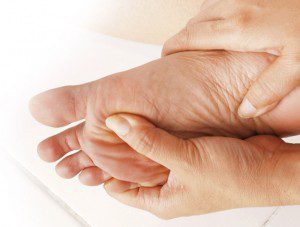By Brian K. Doerr, DPM, Fellow of the American College of Foot & Ankle Surgeons –
 Diabetes impairs the body’s ability to convert sugars and other similar foods such as starches into energy. The longterm effects of elevated blood sugar (also known as hyperglycemia) can lead to serious damage to the eyes, heart, kidney, nerves, and feet. Diabetes affects the lives of nearly 26 million people in the United States and nearly seven million don’t even know they have the disease yet.
Diabetes impairs the body’s ability to convert sugars and other similar foods such as starches into energy. The longterm effects of elevated blood sugar (also known as hyperglycemia) can lead to serious damage to the eyes, heart, kidney, nerves, and feet. Diabetes affects the lives of nearly 26 million people in the United States and nearly seven million don’t even know they have the disease yet.
While there is no cure for diabetes, there is hope. With proper diet, exercise, medical care, and careful management at home, a person with diabetes can avoid the most serious complications and enjoy a full and active life. Today’s podiatrist plays a key role in helping patients manage diabetes successfully and avoid foot-related complications.
Are my symptoms associated with diabetes?
Unless you are routinely checking your blood sugars, or performing a neurologic or vascular assessment, you may not know that you are developing some of the common symptoms associated with diabetes. In many cases, some of these early signs will develop in the feet and legs.
It is the neurologic and vascular changes that create the greatest feet risks for those that develop diabetes. If there is poor circulation (vascular impairment) to the feet, you may develop changes such as skin color changes, swelling of the foot or ankle, numbness in the feet or toes, pain in the legs, open sores on the feet that are slow to heal, ingrown and fungal toenails, bleeding corns and calluses, and dry cracks in the skin, especially around the heel. The above changes (or symptoms) can become more troublesome if the impaired circulation is complicated by what is known as a diabetic peripheral neuropathy.
When you have a diabetic peripheral neuropathy, you have impaired or loss of sensation (neurologic changes). By loss of sensation, this means that you cannot feel what the average person feels. An example of a diabetic with a peripheral neuropathy and vascular impairment is that you could have something as simple as a seam on your shoe irritate a portion of the foot without your knowledge and this can easily progress to much more serious problems such as infection, amputation, and even loss of life. These problems become life threatening because you are not aware that they are affecting you.
These areas of concern can easily be checked by your podiatrist, and the potential risks can be significantly reduced.
Visit Your Podiatrist
Because diabetes is a disease affecting many parts of the body, successful management requires a team approach. Today’s podiatrist is an integral part of a diabetes treatment team. There is documented success that with the proper podiatry care amputations are prevented.
Did you know that more than 65,000 lower limbs are amputated annually due to complications from diabetes and that after an amputation, the chance of another amputation within three to five years is as high as 50 percent?
The keys to amputation prevention are early recognition and regular foot screenings performed by a podiatrist, the foot and ankle expert. Including a podiatrist in your diabetes care can reduce the risk of lower limb amputation up to 85 percent and lowers the risk of hospitalization by 24 percent
Take Action Today to Keep Your
Feet to Last a Lifetime
If you have diabetes, here are some simple foot care tips:
• Inspect feet routinely. Check your feet and toes for cuts, bruises, sores, or changes to the toenails, such as thickening or discoloration.
• Wear thick, soft socks. Avoid socks with seams, which could rub and cause blisters or other skin injuries. Also, wear white socks so that if you do have a problem, you may see it when you change your socks.
• Exercise. Walking can keep weight down and improve circulation. Be sure to wear appropriate athletic shoes when exercising. Exercise also helps the body to break down the sugars in your body which in turn can help your diabetes.
• Have new shoes properly measured and fitted. Foot size and shape may change over time. As we age, we typically do see an increase in shoe width and length.
• Don’t go barefoot. Don’t go without shoes, even in your own home. The risk of cuts and infection is too great for those with diabetes.
• Never try to remove calluses, corns, or warts by yourself. Over-the-counter products can burn the skin and cause irreparable damage to the foot for people with diabetes.
• See your podiatrist. Regular checkups by a podiatrist—at least annually—are the best way to ensure that your feet remain healthy.
Brian K. Doerr, DPM
239.931.3668
www.docdoerr.com









